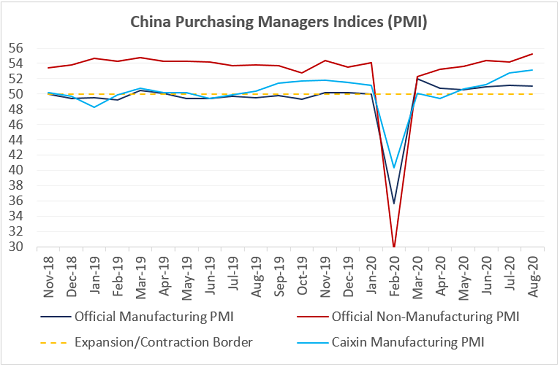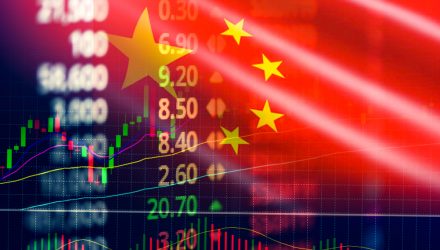By Natalia Gurushina, Chief Economist, Emerging Markets Fixed Income Strategy, VanEck Global
China’s recovery is progressing well, with more contribution from consumption and smaller companies. Turkey’s credit-driven growth is putting a lid on external adjustment.
The main takeaway from China’s latest activity gauges (Purchasing Managers Indices, PMI) is that the recovery is gaining pace and getting more balanced (smaller supply-demand gap). Both the official and Caixin manufacturing PMIs looked upbeat, while the official services PMI accelerated to 55.9, surprising to the upside (see chart below). Other encouraging developments included (1) stronger new orders (52.8); (2) new export orders PMI finally moving to expansion zone (subsiding global headwinds); and (3) a sharp improvement in the small companies PMI (from 47.7 to 50.1). The last development indicates that the transmission mechanism might be working better, and that authorities made the right choice focusing on the targeted (“drip”) stimulus rather than flooding the system with cheap credit (like in past crises).
The Turkish currency is down by nearly 30% so far this year, the country’s terms of trade are no longer worsening, but there are still very few signs of adjustment in external balances. The trade deficit widened to USD6.28B in August, and there was no improvement in both 6-month and 12-month moving averages. Surging imports (up by 20.4% year-on-year) suggest that credit-dependent growth might be to blame. In this regard, the central bank’s unexpected policy U-turn last week (a rate hike) provides a glimmer of hope.
South Africa’s headline inflation edged lower in August (3.1% year-on-year), but core inflation continued to grind up, as the country consumption patterns are adjusting to the removal of the COVID restrictions. We do not think there is any pressure on the central bank to act right now—monetary authorities had confirmed their cautious bias by keeping the policy rate on hold in September (against the consensus expectation of a cut). The next important milestone for the inflation outlook is October’s medium-term budget policy statement.

Chart at a Glance: China’s Recovery Is Gaining Pace
Source: Bloomberg LP
IMPORTANT DEFINITIONS & DISCLOSURES
PMI – Purchasing Managers’ Index: economic indicators derived from monthly surveys of private sector companies; ISM – Institute for Supply Management PMI: ISM releases an index based on more than 400 purchasing and supply managers surveys; both in the manufacturing and non-manufacturing industries; CPI – Consumer Price Index: an index of the variation in prices paid by typical consumers for retail goods and other items; PPI – Producer Price Index: a family of indexes that measures the average change in selling prices received by domestic producers of goods and services over time; PCE inflation – Personal Consumption Expenditures Price Index: one measure of U.S. inflation, tracking the change in prices of goods and services purchased by consumers throughout the economy; MSCI – Morgan Stanley Capital International: an American provider of equity, fixed income, hedge fund stock market indexes, and equity portfolio analysis tools; VIX – CBOE Volatility Index: an index created by the Chicago Board Options Exchange (CBOE), which shows the market’s expectation of 30-day volatility. It is constructed using the implied volatilities on S&P 500 index options.; GBI-EM – JP Morgan’s Government Bond Index – Emerging Markets: comprehensive emerging market debt benchmarks that track local currency bonds issued by Emerging market governments.; EMBI – JP Morgan’s Emerging Market Bond Index: JP Morgan’s index of dollar-denominated sovereign bonds issued by a selection of emerging market countries; EMBIG – JP Morgan’s Emerging Market Bond Index Global: tracks total returns for traded external debt instruments in emerging markets.
The information presented does not involve the rendering of personalized investment, financial, legal, or tax advice. This is not an offer to buy or sell, or a solicitation of any offer to buy or sell any of the securities mentioned herein. Certain statements contained herein may constitute projections, forecasts and other forward looking statements, which do not reflect actual results. Certain information may be provided by third-party sources and, although believed to be reliable, it has not been independently verified and its accuracy or completeness cannot be guaranteed. Any opinions, projections, forecasts, and forward-looking statements presented herein are valid as the date of this communication and are subject to change.
Investing in international markets carries risks such as currency fluctuation, regulatory risks, economic and political instability. Emerging markets involve heightened risks related to the same factors as well as increased volatility, lower trading volume, and less liquidity. Emerging markets can have greater custodial and operational risks, and less developed legal and accounting systems than developed markets.
All investing is subject to risk, including the possible loss of the money you invest. As with any investment strategy, there is no guarantee that investment objectives will be met and investors may lose money. Diversification does not ensure a profit or protect against a loss in a declining market. Past performance is no guarantee of future performance.







